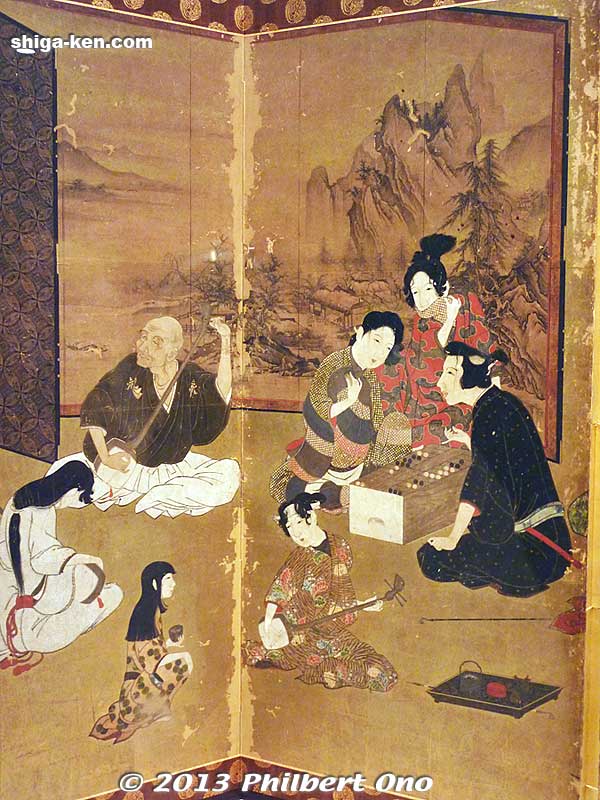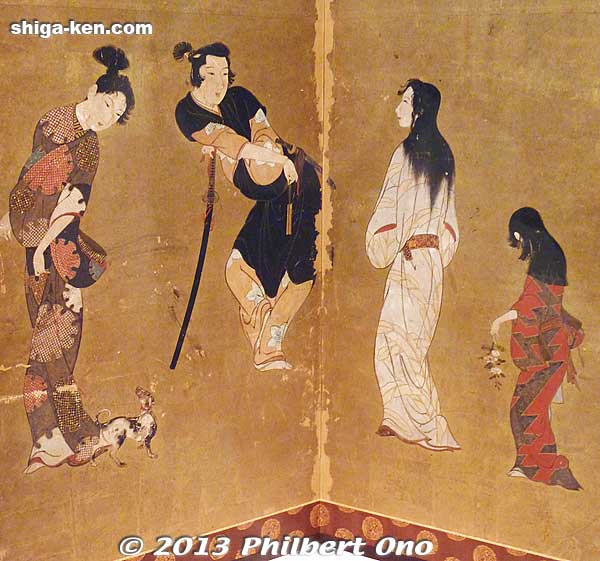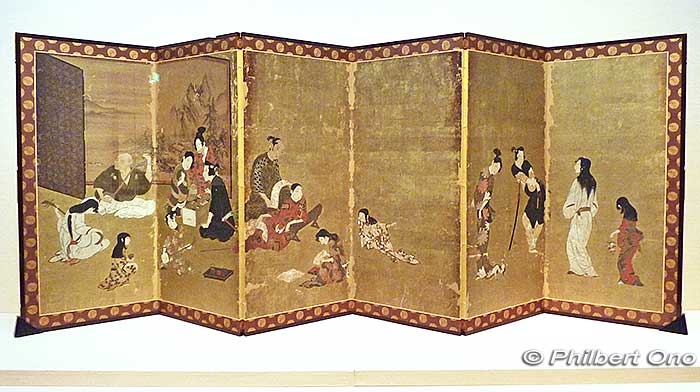
Updated: April 25, 2024
Hikone Castle Museum exhibits the Hikone Byobu folding screen (彦根屏風), a National Treasure, every spring usually for a month from mid-April to mid-May. In 2023, the screen will be exhibited from April 25 to May 14, 2024.
Shiga Prefecture has only four paintings that are National Treasures, and this is one of them and the only non-religious one. The others are all religious paintings owned by temples like Miidera. (Japan has 158 paintings designated as National Treasures as of this writing.) The byobu folding screen shows a pleasure quarters scene in Kyoto. It’s painted on a gold-leaf paper background.
The six-panel byobu is dated to be from the Edo Period’s Kan’ei era (1624-44). It measures 271 cm wide and 94 cm high. Since it was kept by the Ii clan (lord of Hikone Castle) for generations, the screen is nicknamed “Hikone Byobu” even though the painting is not related to Hikone.
The byobu’s official name is a mouthful: Shihon Kinjichaku-shoku Fuzoku-zu (紙本金地著色風俗図). The Ii family donated the screen to Hikone and the city of Hikone owns the byobu (since 1997). The Hikone Byobu underwent meticulous repairs for two years and it is exhibited for about a month every spring.
The byobu’s National Treasure acclaim is due to the highly skilled and meticulous painting style and the myriad of people, fashion, and objects depicted from that era. Extremely fine lines and dots are painted for the hair, kimono patterns, etc. You’ll need a magnifying glass to see all that intricate detail (although you won’t be able to get that close to the painting).
The painted scene is an outstanding snapshot of the people and customs of that time. Thus, it is called a fuzoku-zu (風俗図). With so many little details pictured, you would have to be well-versed in the arts, fashion, customs, and history of that period to fully appreciate what is depicted.
Left side of Hikone byobu screen is an indoor scene.
On the left side of the byobu, you can see a folding screen with a Chinese-style painting. This is the only prop we see in the background and it indicates that the scene on the left half of the screen is indoors where everyone is sitting close together.
The right half of the screen looks like it’s outdoors since the people are standing and one woman is walking her little dog (imported from Europe) even. We see no boundary between the indoors and outdoors, but it is obviously implied.
On the screen’s left half showing the indoor scene, three people are playing the samisen and three people are playing Japanese backgammon called sugoroku (双六). There is also a long tobacco pipe below the backgammon player dressed in black. Tobacco pipes were imported from Spain and Portugal at the time and were very popular in Japan. Their length eventually got shorter in later years.
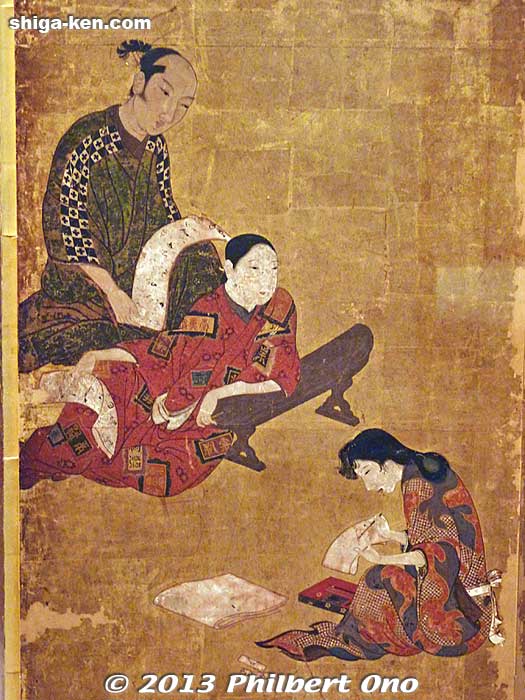
On the lower right in the indoor scene is a girl writing a love letter with ink and brush. The samisen players, sugoroku players, letter writer, and background folding screen all refer to the Chinese-originated cultural concept of kinkishoga (琴棋書画), meaning stringed instrument (koto), traditional board game, calligraphy, and painting. Being skilled at these four traditional arts was considered a prerequisite of a cultured person. It was common for paintings to depict kinkishoga.
Above the letter writer is a middle-age woman leaning on an arm rest. She is thought to be a Buddhist layman of great knowledge, making her the de facto supervisor there.
Right side of Hikone byobu screen is an outdoor scene. Human characters also match the folding panel’s inward and outward angles
The pleasure quarters was for people of taste and culture. It was a leading edge for fashion and we can see various fashion statements in the painting. The people wear a variety of hairstyles. For example, the karawa-mage style (唐輪髷) with the hair stacked up was favored by the courtesans of that day. We also see short-sleeve casual kimono called kosode (小袖) and they also have gold leaf embedded in the material.
On the right side of the byobu, the woman second from the right edge is wearing an almost white kimono with a basho (banana plant or Musa basjoo) design. It reminds one of a Noh song titled, Basho. (Famous haiku poet Basho named himself after the banana plant.)
When the Hikone Byobu was made in the early Edo Period, it wasn’t for the masses to see. Only the cultural elite would be able to see it and the artist knew this. The artist therefore included small details that only the cultural elite would appreciate and understand. They would have been well-versed in Chinese-style painting, religious paintings, Noh plays, etc.
The painting was designed to be viewed not as a flat painting, but on a folding screen with its characteristic zig-zag panels facing inward or outward. The people were painted to match the respective panel’s angle. If you look closely, you can see that the way the people are facing are indeed enhanced or emphasized by the inward or outward angle of the panel.
Since the painting was not signed, the artist is unknown. However, experts say that the painter likely belonged to the Kano school of Japanese painting. It’s astonishing that the artist did not sign such a masterpiece. I wonder if the artist didn’t sign it because the work was still unfinished (the background looks too empty to me) or maybe there were multiple artists. There are still things about the painting that experts do not know about.
I first went to see this byobu during Golden Week in 2012 and again in 2013 for a closer look. I went without reading up about it, so I was unable to fully appreciate the byobu’s artistic and cultural value when I saw it. It was only after I did some reading when I was able to appreciate this rare National Treasure. Now share with you what I’ve learned about this fascinating byobu. Appreciate it for what it’s really worth, which is a lot. A little knowledge (and language) goes a long way.
The Hikone Castle Museum is next to the ticket booth to enter Hikone Castle, a short walk from JR Hikone Station. The building is a reconstruction of the castle palace. Open 8:30 am to 5 pm (enter by 4:30 pm). Admission is ¥500 for adults (cheaper if you also buy a ticket to enter Hikone Castle) and ¥250 for high school and younger.
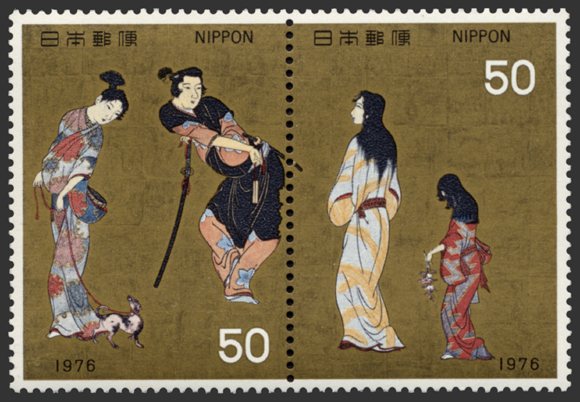
Related posts at shiga-ken.com:
Hikone Castle photos – Over 280 photos of Hikone castle.
About Hikone – Overview of the city of Hikone.
Google map of Hikone – Main sights listed.
Hikone Castle video – Comprehensive 34-min. video about the castle, its history, Genkyuen Garden, and autumn castle festivals.
